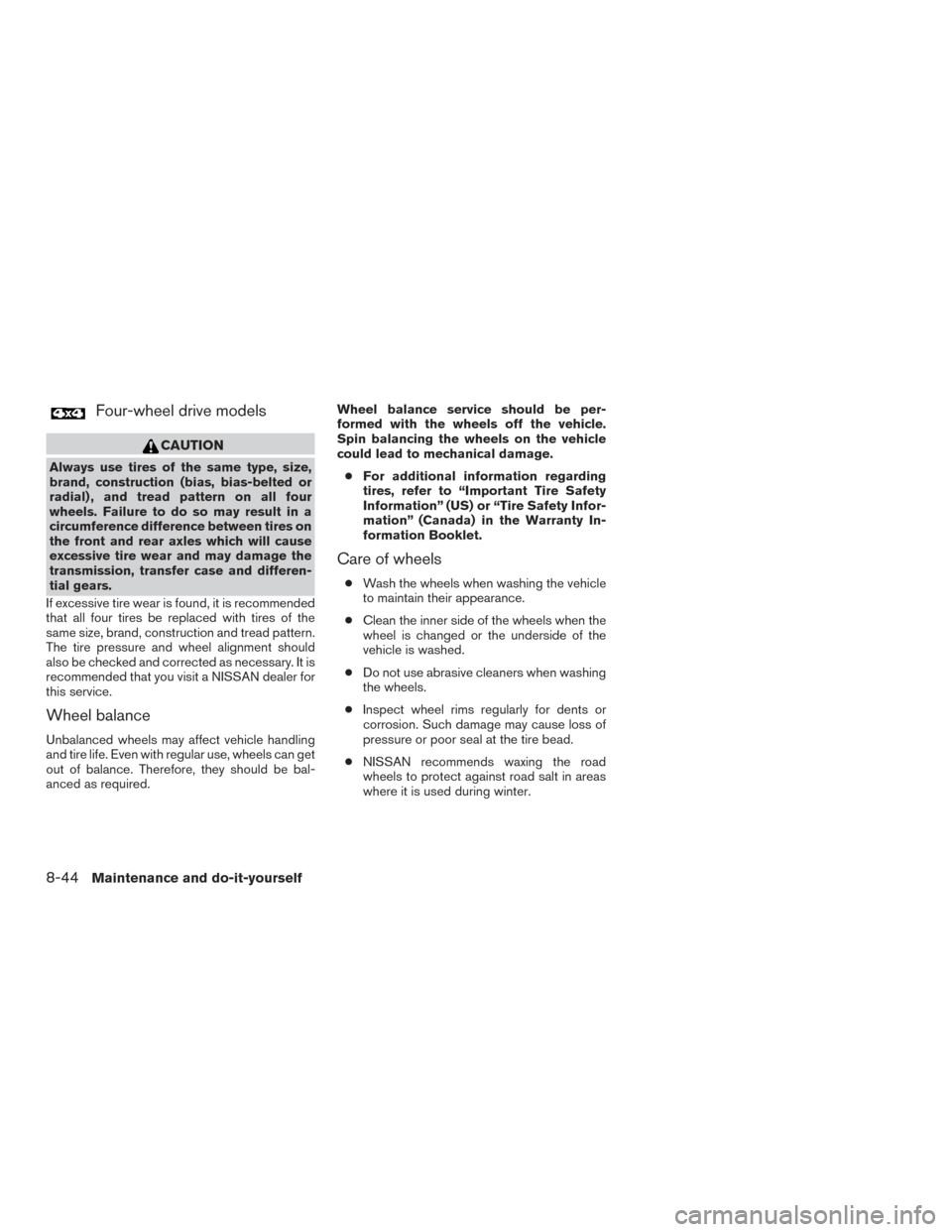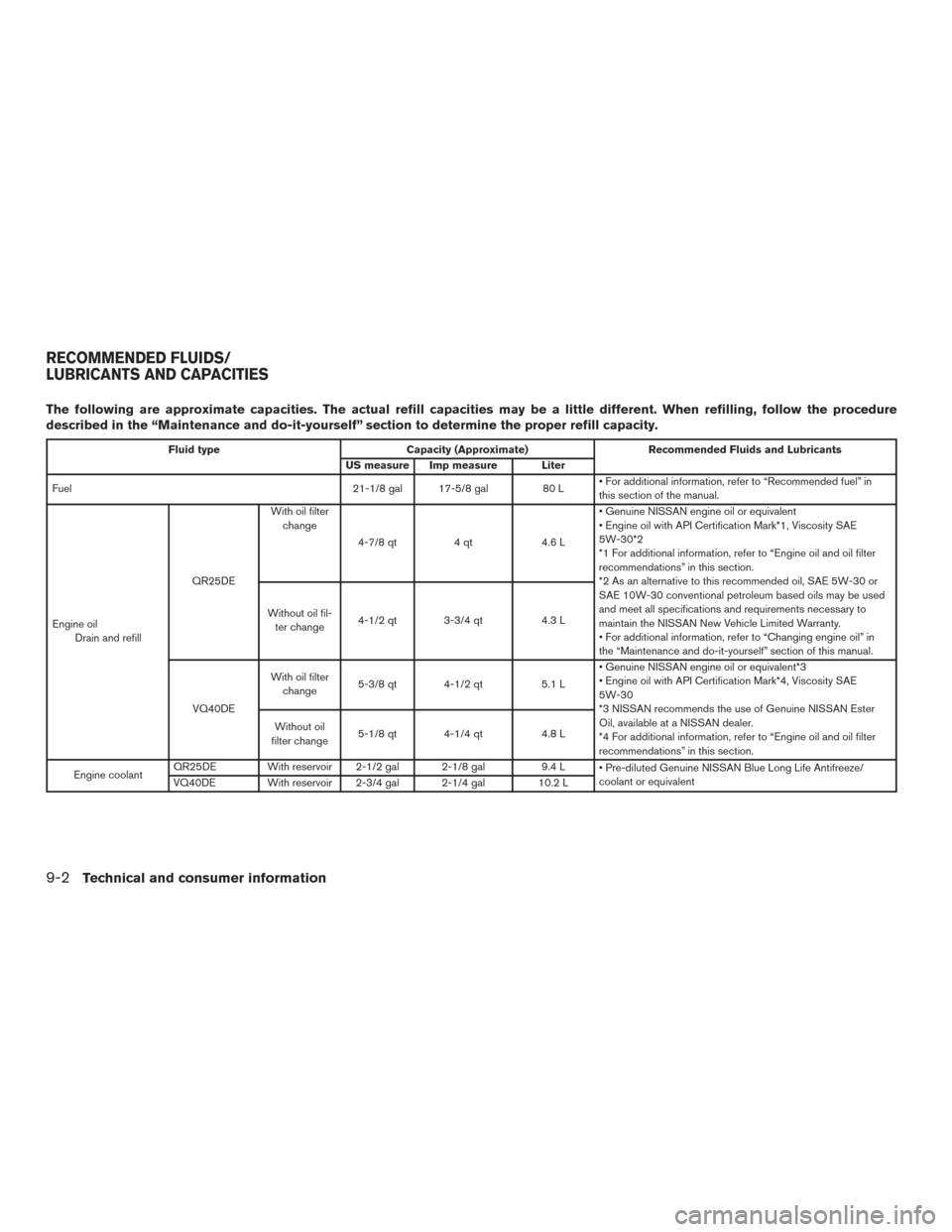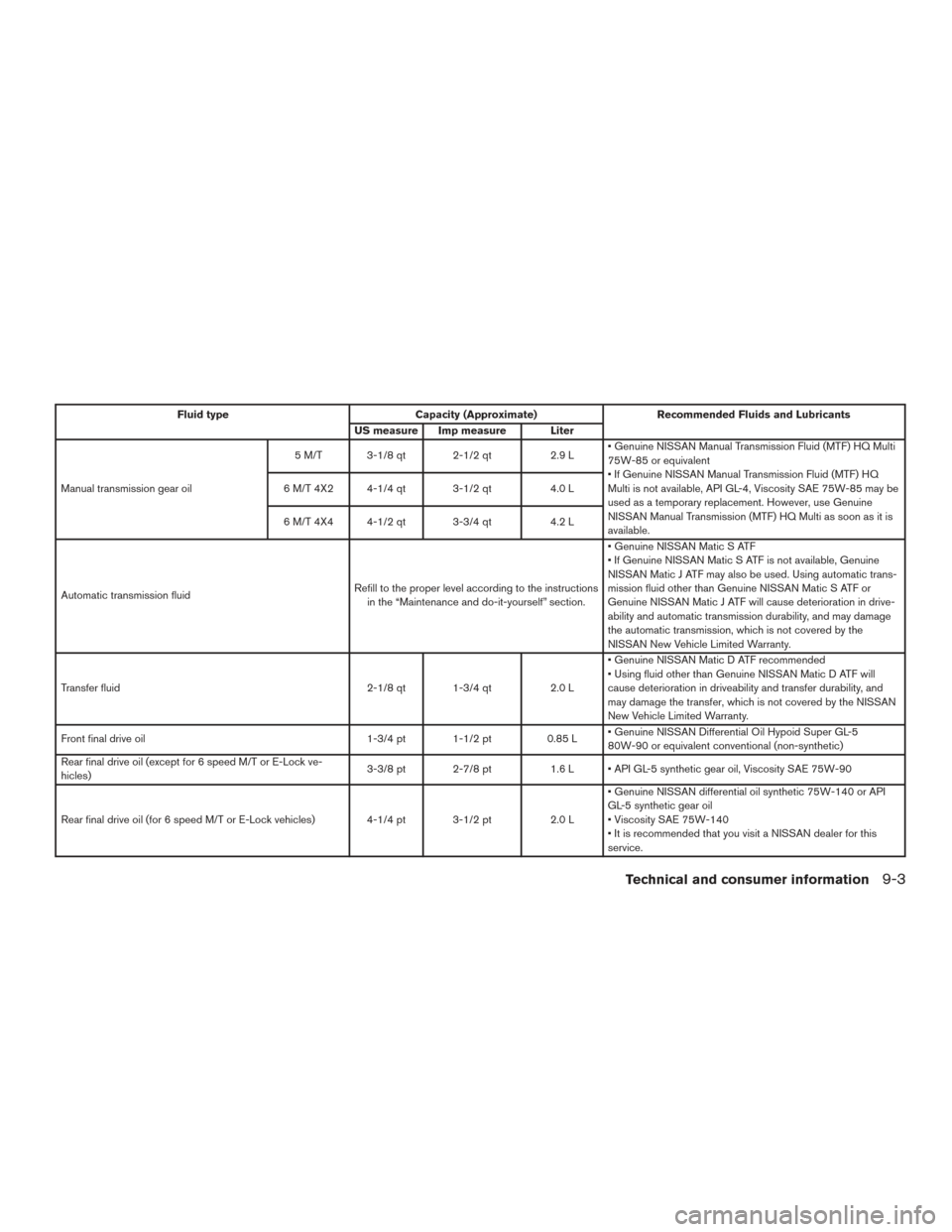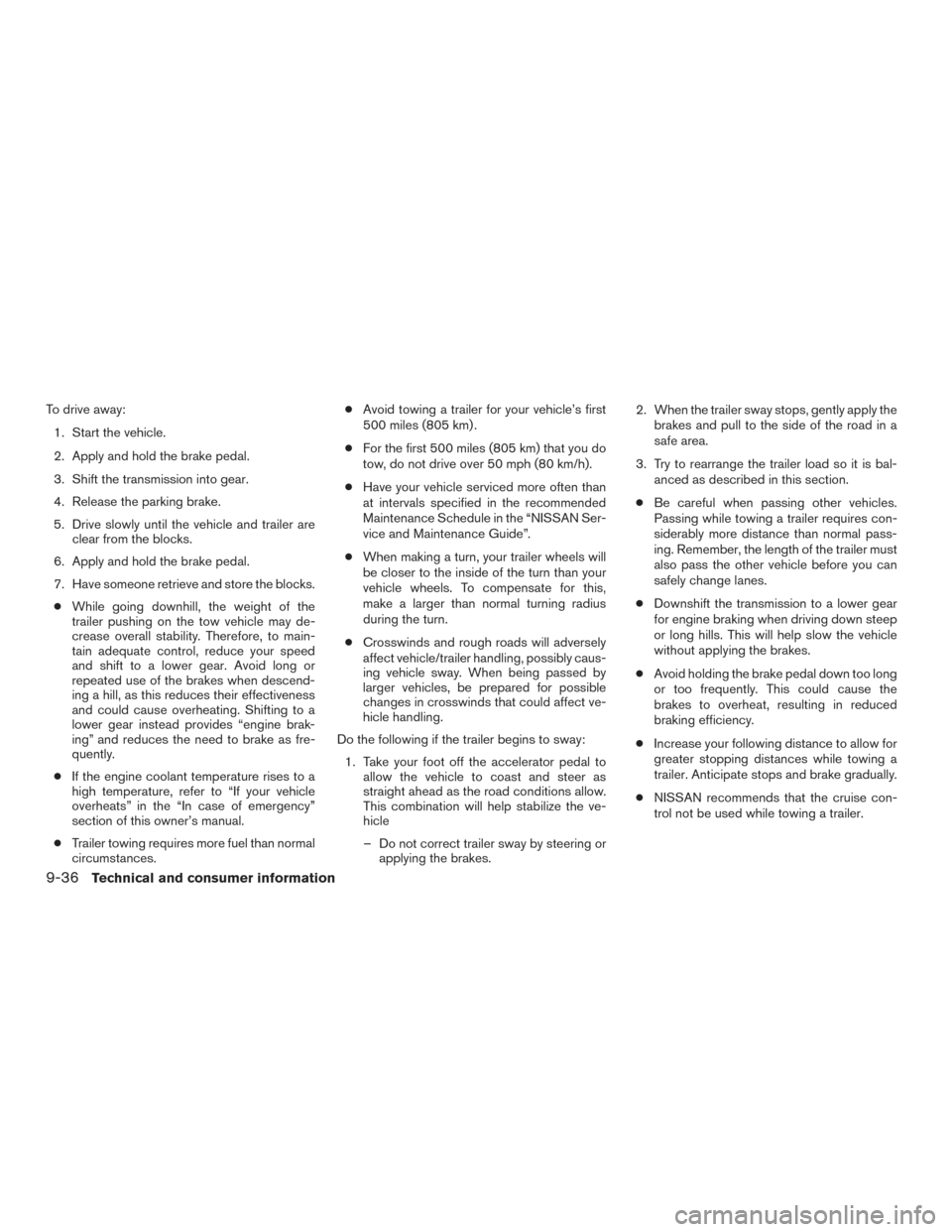2016 NISSAN FRONTIER maintenance
[x] Cancel search: maintenancePage 417 of 469

Four-wheel drive models
CAUTION
Always use tires of the same type, size,
brand, construction (bias, bias-belted or
radial) , and tread pattern on all four
wheels. Failure to do so may result in a
circumference difference between tires on
the front and rear axles which will cause
excessive tire wear and may damage the
transmission, transfer case and differen-
tial gears.
If excessive tire wear is found, it is recommended
that all four tires be replaced with tires of the
same size, brand, construction and tread pattern.
The tire pressure and wheel alignment should
also be checked and corrected as necessary. It is
recommended that you visit a NISSAN dealer for
this service.
Wheel balance
Unbalanced wheels may affect vehicle handling
and tire life. Even with regular use, wheels can get
out of balance. Therefore, they should be bal-
anced as required. Wheel balance service should be per-
formed with the wheels off the vehicle.
Spin balancing the wheels on the vehicle
could lead to mechanical damage.
● For additional information regarding
tires, refer to “Important Tire Safety
Information” (US) or “Tire Safety Infor-
mation” (Canada) in the Warranty In-
formation Booklet.
Care of wheels
●Wash the wheels when washing the vehicle
to maintain their appearance.
● Clean the inner side of the wheels when the
wheel is changed or the underside of the
vehicle is washed.
● Do not use abrasive cleaners when washing
the wheels.
● Inspect wheel rims regularly for dents or
corrosion. Such damage may cause loss of
pressure or poor seal at the tire bead.
● NISSAN recommends waxing the road
wheels to protect against road salt in areas
where it is used during winter.
8-44Maintenance and do-it-yourself
Page 418 of 469

9 Technical and consumer information
Recommended fluids/lubricants and capacities.......9-2
Fuel recommendation ...........................9-5
Engine oil and oil filter recommendations ..........9-7
Air conditioner system (if so equipped)
refrigerant and oil recommendations ..............9-8
Specifications .....................................9-9
Engine ........................................9-9
Wheels and tires .............................. 9-10
Dimensions and weights .......................9-11
When traveling or registering in another country ......9-12
Vehicle identification .............................. 9-12
Vehicle identification number (VIN) plate .........9-12
Engine serial number ........................... 9-13
F.M.V.S.S./C.M.V.S.S. certification label ..........9-13
Emission control information label ...............9-13
Tire and loading information label ................9-14
Air conditioner specification label
(if so equipped) ............................... 9-14
Installing front license plate ........................9-14
Installing front license plate with grommets .......9-14
Installing front license plate without
grommets .................................... 9-15
Vehicle loading information ........................9-15
Terms ........................................ 9-15
Vehicle load capacity .......................... 9-16Securing the load
.............................. 9-18
Utili-track™ channel system (if so equipped) ......9-19
Loading tips .................................. 9-24
Truck-camper loading information ..................9-24
Crew cab models .............................. 9-24
King Cab models .............................. 9-24
Special Body vehicles .......................... 9-24
Location for center of gravity ....................9-25
Vehicle load weight capacity ....................9-25
Measurement of weights .......................9-26
Towing a trailer ................................... 9-26
Maximum load limits ........................... 9-26
Towing load/specification .......................9-30
Towing safety ................................. 9-31
Flat towing
for 4–Wheel drive vehicle
(if so equipped) ............................... 9-37
Flat towing for rear wheel drive vehicle
(if so equipped) ............................... 9-37
Uniform tire quality grading ........................9-38
Emission control system warranty ..................9-39
Reporting safety defects .......................... 9-39
Readiness for inspection/maintenance (I/M) test .....9-40
Event Data Recorders (EDR) .......................9-41
Owner’s Manual/Service Manual order information . . . 9-41
Page 419 of 469

The following are approximate capacities. The actual refill capacities may be a little different. When refilling, follow the procedure
described in the “Maintenance and do-it-yourself” section to determine the proper refill capacity.
Fluid typeCapacity (Approximate) Recommended Fluids and Lubricants
US measure Imp measure Liter
Fuel 21-1/8 gal 17-5/8 gal80 L• For additional information, refer to “Recommended fuel” in
this section of the manual.
Engine oil Drain and refill QR25DEWith oil filter
change
4-7/8 qt 4 qt4.6 L• Genuine NISSAN engine oil or equivalent
• Engine oil with API Certification Mark*1, Viscosity SAE
5W-30*2
*1 For additional information, refer to “Engine oil and oil filter
recommendations” in this section.
*2 As an alternative to this recommended oil, SAE 5W-30 or
SAE 10W-30 conventional petroleum based oils may be used
and meet all specifications and requirements necessary to
maintain the NISSAN New Vehicle Limited Warranty.
• For additional information, refer to “Changing engine oil” in
the “Maintenance and do-it-yourself” section of this manual.
Without oil fil-
ter change 4-1/2 qt 3-3/4 qt
4.3 L
VQ40DE With oil filter
change 5-3/8 qt 4-1/2 qt
5.1 L• Genuine NISSAN engine oil or equivalent*3
• Engine oil with API Certification Mark*4, Viscosity SAE
5W-30
*3 NISSAN recommends the use of Genuine NISSAN Ester
Oil, available at a NISSAN dealer.
*4 For additional information, refer to “Engine oil and oil filter
recommendations” in this section.
Without oil
filter change 5-1/8 qt 4-1/4 qt
4.8 L
Engine coolant QR25DE With reservoir 2-1/2 gal 2-1/8 gal
9.4 L
• Pre-diluted Genuine NISSAN Blue Long Life Antifreeze/
coolant or equivalent
VQ40DE With reservoir 2-3/4 gal 2-1/4 gal 10.2 L
RECOMMENDED FLUIDS/
LUBRICANTS AND CAPACITIES
9-2Technical and consumer information
Page 420 of 469

Fluid typeCapacity (Approximate) Recommended Fluids and Lubricants
US measure Imp measure Liter
Manual transmission gear oil 5 M/T 3-1/8 qt 2-1/2 qt
2.9 L• Genuine NISSAN Manual Transmission Fluid (MTF) HQ Multi
75W-85 or equivalent
• If Genuine NISSAN Manual Transmission Fluid (MTF) HQ
Multi is not available, API GL-4, Viscosity SAE 75W-85 may be
used as a temporary replacement. However, use Genuine
NISSAN Manual Transmission (MTF) HQ Multi as soon as it is
available.
6 M/T 4X2 4-1/4 qt 3-1/2 qt
4.0 L
6 M/T 4X4 4-1/2 qt 3-3/4 qt 4.2 L
Automatic transmission fluid Refill to the proper level according to the instructions
in the “Maintenance and do-it-yourself” section. • Genuine NISSAN Matic S ATF
• If Genuine NISSAN Matic S ATF is not available, Genuine
NISSAN Matic J ATF may also be used. Using automatic trans-
mission fluid other than Genuine NISSAN Matic S ATF or
Genuine NISSAN Matic J ATF will cause deterioration in drive-
ability and automatic transmission durability, and may damage
the automatic transmission, which is not covered by the
NISSAN New Vehicle Limited Warranty.
Transfer fluid 2-1/8 qt 1-3/4 qt2.0 L• Genuine NISSAN Matic D ATF recommended
• Using fluid other than Genuine NISSAN Matic D ATF will
cause deterioration in driveability and transfer durability, and
may damage the transfer, which is not covered by the NISSAN
New Vehicle Limited Warranty.
Front final drive oil 1-3/4 pt 1-1/2 pt0.85 L• Genuine NISSAN Differential Oil Hypoid Super GL-5
80W-90 or equivalent conventional (non-synthetic)
Rear final drive oil (except for 6 speed M/T or E-Lock ve-
hicles) 3-3/8 pt 2-7/8 pt
1.6 L • API GL-5 synthetic gear oil, Viscosity SAE 75W-90
Rear final drive oil (for 6 speed M/T or E-Lock vehicles) 4-1/4 pt 3-1/2 pt 2.0 L• Genuine NISSAN differential oil synthetic 75W-140 or API
GL-5 synthetic gear oil
• Viscosity SAE 75W-140
• It is recommended that you visit a NISSAN dealer for this
service.
Technical and consumer information9-3
Page 425 of 469

Oil viscosity
The engine oil viscosity or thickness changes
with temperature. Because of this, it is important
to select the engine oil viscosity based on the
temperatures at which the vehicle will be oper-
ated before the next oil change. Choosing an oil
viscosity other than that recommended could
cause serious engine damage.
Selecting the correct oil filter
Your new NISSAN vehicle is equipped with a
high-quality Genuine NISSAN oil filter. When
replacing, use a Genuine NISSAN oil filter or its
equivalent for the reason described in “Change
intervals.”
Change intervals
The oil and oil filter change intervals for your
engine are based on the use of the specified
quality oils and filters. Using engine oil and filters
that are not of the specified quality, or exceeding
recommended oil and filter change intervals
could reduce engine life. Damage to the engine
caused by improper maintenance or use of incor-
rect oil and filter quality and/or viscosity is not
covered by the NISSAN New Vehicle Limited
Warranty.Your engine was filled with a high-quality engine
oil when it was built. You do not have to change
the oil before the first recommended change
interval. Oil and filter change intervals depend
upon how you use your vehicle.
Operation under the following conditions may
require more frequent oil and filter changes:
● repeated short distance driving at cold out-
side temperatures
● driving in dusty conditions
● extensive idling
● towing a trailer
● stop and go commuting
For additional information, refer to “NISSAN Ser-
vice and Maintenance Guide” for the mainte-
nance schedule.
AIR CONDITIONER SYSTEM (if so
equipped) REFRIGERANT AND OIL
RECOMMENDATIONS
The air conditioner system in your NISSAN
vehicle must be charged with the refriger-
ant HFC-134a (R-134a) and NISSAN A/C
system oil Type DH-PR or the exact equiva-
lents.
CAUTION
The use of any other refrigerant or oil will
cause severe damage to the air condition-
ing system and will require the replace-
ment of all air conditioner system
components.
The refrigerant HFC-134a (R-134a) in your
NISSAN vehicle does not harm the earth’s ozone
layer. Although this refrigerant does not affect the
earth’s atmosphere, certain government regula-
tions require the recovery and recycling of any
refrigerant during automotive air conditioner sys-
tem service. A NISSAN dealer has the trained
technicians and equipment needed to recover
and recycle your air conditioner system refriger-
ant.
It is recommended that you visit a NISSAN dealer
when servicing your air conditioner system.
9-8Technical and consumer information
Page 435 of 469

5. Determine the combined weight ofluggage and cargo being loaded on
the vehicle. That weight may not
safely exceed the available cargo and
luggage load capacity calculated in
step 4.
6. If your vehicle will be towing a trailer, load from your trailer will be trans-
ferred to your vehicle. Consult this
manual to determine how this re-
duces the available cargo and lug-
gage load capacity of your vehicle.
Before driving a loaded vehicle, confirm
that you do not exceed the GVWR or the
GAWR for your vehicle. For additional
information, refer to “Measurement of
weights” in this section.
Also check tires for proper inflation pres-
sures. For additional information, refer to
the “Tire and Loading Information label” in
the Maintenance and do-it-yourself” sec-
tion of this manual.
SECURING THE LOAD
For your convenience, tie down hooks (if so
equipped) are placed at each corner of the truck
box. These may be used to help secure cargo
loaded into the truck box.
WARNING
● Properly secure all cargo with ropes or
straps to help prevent it from sliding or
shifting. Do not place cargo higher than
the seatbacks. In a sudden stop or col-
lision, unsecured cargo could cause
personal injury.
● Do not load your vehicle any heavier
than the GVWR or the maximum front
and rear GAWRs. If you do, parts of your
vehicle can break, tire damage could
occur, or it can change the way your
vehicle handles. This could result in loss
of control and cause personal injury.
LTI0102
9-18Technical and consumer information
Page 453 of 469

To drive away:1. Start the vehicle.
2. Apply and hold the brake pedal.
3. Shift the transmission into gear.
4. Release the parking brake.
5. Drive slowly until the vehicle and trailer are clear from the blocks.
6. Apply and hold the brake pedal.
7. Have someone retrieve and store the blocks. ● While going downhill, the weight of the
trailer pushing on the tow vehicle may de-
crease overall stability. Therefore, to main-
tain adequate control, reduce your speed
and shift to a lower gear. Avoid long or
repeated use of the brakes when descend-
ing a hill, as this reduces their effectiveness
and could cause overheating. Shifting to a
lower gear instead provides “engine brak-
ing” and reduces the need to brake as fre-
quently.
● If the engine coolant temperature rises to a
high temperature, refer to “If your vehicle
overheats” in the “In case of emergency”
section of this owner’s manual.
● Trailer towing requires more fuel than normal
circumstances. ●
Avoid towing a trailer for your vehicle’s first
500 miles (805 km) .
● For the first 500 miles (805 km) that you do
tow, do not drive over 50 mph (80 km/h).
● Have your vehicle serviced more often than
at intervals specified in the recommended
Maintenance Schedule in the “NISSAN Ser-
vice and Maintenance Guide”.
● When making a turn, your trailer wheels will
be closer to the inside of the turn than your
vehicle wheels. To compensate for this,
make a larger than normal turning radius
during the turn.
● Crosswinds and rough roads will adversely
affect vehicle/trailer handling, possibly caus-
ing vehicle sway. When being passed by
larger vehicles, be prepared for possible
changes in crosswinds that could affect ve-
hicle handling.
Do the following if the trailer begins to sway: 1. Take your foot off the accelerator pedal to allow the vehicle to coast and steer as
straight ahead as the road conditions allow.
This combination will help stabilize the ve-
hicle
– Do not correct trailer sway by steering or applying the brakes. 2. When the trailer sway stops, gently apply the
brakes and pull to the side of the road in a
safe area.
3. Try to rearrange the trailer load so it is bal- anced as described in this section.
● Be careful when passing other vehicles.
Passing while towing a trailer requires con-
siderably more distance than normal pass-
ing. Remember, the length of the trailer must
also pass the other vehicle before you can
safely change lanes.
● Downshift the transmission to a lower gear
for engine braking when driving down steep
or long hills. This will help slow the vehicle
without applying the brakes.
● Avoid holding the brake pedal down too long
or too frequently. This could cause the
brakes to overheat, resulting in reduced
braking efficiency.
● Increase your following distance to allow for
greater stopping distances while towing a
trailer. Anticipate stops and brake gradually.
● NISSAN recommends that the cruise con-
trol not be used while towing a trailer.
9-36Technical and consumer information
Page 454 of 469

●Some states or provinces have specific
regulations and speed limits for vehicles that
are towing trailers. Obey the local speed
limits.
● Check your hitch, trailer wiring harness con-
nections, and trailer wheel lug nuts after
50 miles (80 km) of travel and at every break.
● When launching a boat, don’t allow the wa-
ter level to go over the exhaust tail pipe or
rear bumper.
● Make sure you disconnect the trailer lights
before backing the trailer into the water or
the trailer lights may burn out.
When towing a trailer, final drive gear oil
should be replaced and transmission
oil/fluid should be changed more fre-
quently. For additional information, refer to
“Maintenance and do-it-yourself” section
in this manual.
FLAT TOWING FOR 4–WHEEL
DRIVE VEHICLE (if so equipped)
Towing your vehicle with all four wheels on the
ground is sometimes called flat towing. This
method is sometimes used when towing a vehicle
behind a recreational vehicle, such as a motor
home.
CAUTION
● Failure to follow these guidelines can
result in severe transmission damage.
● Never flat tow your 4-wheel drive (4WD)
vehicle.
● DO NOT tow your 4-wheel drive (4WD)
vehicle with any wheels on the ground.
Doing so may cause serious and expen-
sive damage to the powertrain.
● For emergency towing procedures refer
to “Towing recommended by NISSAN”
in the “In case of emergency” section of
this manual.
FLAT TOWING FOR REAR WHEEL
DRIVE VEHICLE (if so equipped)
Towing your vehicle with all four wheels on the
ground is sometimes called flat towing. This
method is sometimes used when towing a vehicle
behind a recreational vehicle, such as a motor
home.
CAUTION
●Failure to follow these guidelines can
result in severe transmission damage.
● Whenever flat towing your vehicle, al-
ways tow forward, never backward.
● Never tow your rear wheel drive vehicle
with the front tires on the ground. Doing
so may cause serious and expensive
damage to the powertrain.
● DO NOT tow your rear wheel drive ve-
hicle with all four wheels on the ground
(flat towing) . Doing so WILL DAMAGE
internal transmission parts due to lack
of transmission lubrication.
● For emergency towing procedures refer
to “Towing recommended by NISSAN”
in the “In case of emergency” section of
this manual.
Manual Transmission (if so equipped)
● Always tow with the manual transmission in
Neutral.
● On 4-wheel drive vehicles, place the transfer
case in the 2H range. Failure to do so will
cause the powertrain to bind up.
Technical and consumer information9-37